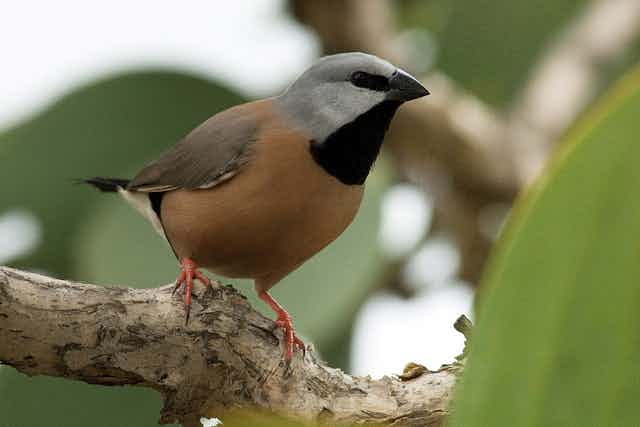The Queensland government has ticked off a crucial environmental approval for Adani’s Carmichael coalmine, bringing the contentious project a step closer to becoming reality.
It has approved Adani’s proposed management plan for the endangered black-throated finch, less than a month after the state’s environment department announced a delay in approval because the plan was judged to be inadequate.
Read more: Why Adani's finch plan was rejected, and what comes next
Four days after the May 18 federal election, in which the mine’s future was a prominent issue, Queensland Premier Annastacia Palaszczuk called for an end to the delays and uncertainty.
In a statement issued today, the government said it has now approved a “strengthened” version of the plan, submitted by Adani earlier this week.
Under the revised plan, Adani has now committed to:
“establish enhanced understanding” of the finch, with the help of “appropriate population studies”
implement “appropriate monitoring protocols” to track the finch’s population over time
restrict grazing in nearby areas.
The only remaining state environmental approval for the project now is Adani’s groundwater management plan, on which a decision is due by June 13.
Bad plan caused the delays
As members of the scientific panel that reviewed the finch management plan, we can understand the Premier’s frustration. There is no excuse for such a poor plan to have been put forward for approval when the company has been aware for almost a decade that the land it wants to mine is home to the largest known remaining population of the black-throated finch.
There has already been ample time to undertake the studies Adani has pledged to carry out in the future. Had it done so before now, it could have put its claims to be able to manage the finch’s extinction risk on a much more solid footing.
As it is, the plan we reviewed made biologically improbable assumptions about the finch, while ignoring what is known about the finch’s precipitous decline so far. Under the plan, people with the curious title of “fauna spotter-catchers” were to find finches and move them “to suitable habitat adjacent to the disturbance, if practical” before the habitat is destroyed.
It sounds impractical, and will in all likelihood prove to be so. If the adjacent habitat already has finches, it is likely to be “full” and so won’t be able to support mining refugees. If it lacks finches, there is probably a very good reason.
The finch has been observed only a handful of times in just a tiny proportion of the area purchased for conservation purposes near the mine site. The finch has had more than 10,000 years to occupy and breed in the proposed conservation area that is supposed to offset the impact of the mine. It hasn’t, and it probably won’t.
As far as can be determined by overlaying the available maps, the proposed conservation area has a different geology and soil type. Adani has categorically failed to provide robust scientific evidence to demonstrate that the conservation reserve will adequately offset the loss of the finches and the habitat in the mined area. It has had more than 10 years to conduct the science to provide the evidence.
Meanwhile, before the existing habitat is mined, the plan had talked about grazing being used to control bushfire fuel loads and reduce the abundance of a weed called buffel grass. Yet grazing is thought to be the main reason the finches have disappeared from most of their once vast range – they once occurred from the Atherton tablelands to northern New South Wales.
The new plan is said to “restrict grazing” but no details are yet available. Under the original plan, the cattle would have got fat on the buffel grass pastures just as they did in all the places where the finch once lived.
Rigorous research
What must really frustrate the Queensland Premier is the contrast between Adani’s efforts with the black-throated finch and the much more rigorous work done by mining companies who find themselves in similar situations. Rio Tinto, for example, is currently funding high-quality research on two other birds, the palm cockatoo and red goshawk, ahead of its planned expansion of bauxite operations on Cape York Peninsula.
Vista Gold, meanwhile, funded research on stress levels in Gouldian finches long before mining was planned to begin at its Mt Todd goldmine in the Northern Territory.
In criticising Adani’s plan, we are not criticising mining. Like all Australians, we use the products of mining every day. We enjoy a high standard of living that is delivered partly by royalties from mining. We also understand that miners (and politicians) in Queensland want to see jobs created.
Most mining companies, however, provide jobs while willingly abiding by national and state legislation. They compromise where necessary to minimise environmental harm. And crucially, they commission research to demonstrate how they can mitigate damage well before that damage occurs, rather than when their operations are already underway.
Read more: Does 'offsetting' work to make up for habitat lost to mining?
In contrast, the so-called research and monitoring that went into Adani’s finch plan seems only to conclude that more research is needed. After nine years, Adani did not even know the population size of the finch, how it moves around the landscape, or even what it eats.
Given the time available, this bird could (and should) have been among the best-studied in Australia. The management plan could then have been based on robust evidence that would show how best to safeguard the finch population.
Now the research and monitoring is a hurried add-on with no proof that the threat posed to the finch can actually be solved and an extinction averted. Given the high stakes involved, Australians might reasonably have expected something altogether more rigorous.

